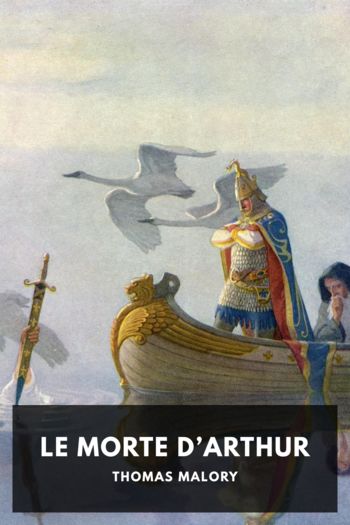Le Morte d’Arthur, Thomas Malory [most popular ebook readers TXT] 📗

- Author: Thomas Malory
Book online «Le Morte d’Arthur, Thomas Malory [most popular ebook readers TXT] 📗». Author Thomas Malory
This ebook is the product of many hours of hard work by volunteers for Standard Ebooks, and builds on the hard work of other literature lovers made possible by the public domain.
This particular ebook is based on a transcription produced for Project Gutenberg and on digital scans available at the Internet Archive.
The writing and artwork within are believed to be in the U.S. public domain, and Standard Ebooks releases this ebook edition under the terms in the CC0 1.0 Universal Public Domain Dedication. For full license information, see the Uncopyright at the end of this ebook.
Standard Ebooks is a volunteer-driven project that produces ebook editions of public domain literature using modern typography, technology, and editorial standards, and distributes them free of cost. You can download this and other ebooks carefully produced for true book lovers at standardebooks.org.
Bibliographical NoteThe Morte d’Arthur was finished, as the epilogue tells us, in the ninth year of Edward IV, i.e. between March 4, 1469 and the same date in 1470. It is thus, fitly enough, the last important English book written before the introduction of printing into this country, and since no manuscript of it has come down to us it is also the first English classic for our knowledge of which we are entirely dependent on a printed text. Caxton’s story of how the book was brought to him and he was induced to print it may be read farther on in his own preface. From this we learn also that he was not only the printer of the book, but to some extent its editor also, dividing Malory’s work into twenty-one books, splitting up the books into chapters, by no means skilfully, and supplying the “Rubrish” or chapter-headings. It may be added that Caxton’s preface contains, moreover, a brief criticism which, on the points on which it touches, is still the soundest and most sympathetic that has been written.
Caxton finished his edition the last day of July 1485, some fifteen or sixteen years after Malory wrote his epilogue. It is clear that the author was then dead, or the printer would not have acted as a clumsy editor to the book, and recent discoveries (if bibliography may, for the moment, enlarge its bounds to mention such matters) have revealed with tolerable certainty when Malory died and who he was. In letters to The Athenaeum in July 1896 Mr. T. Williams pointed out that the name of a Sir Thomas Malorie occurred among those of a number of other Lancastrians excluded from a general pardon granted by Edward IV in 1468, and that a William Mallerye was mentioned in the same year as taking part in a Lancastrian rising. In September 1897, again, in another letter to the same paper, Mr. A. T. Martin reported the finding of the will of a Thomas Malory of Papworth, a hundred partly in Cambridgeshire, partly in Hunts. This will was made on September 16, 1469, and as it was proved the 27th of the next month the testator must have been in immediate expectation of death. It contains the most careful provision for the education and starting in life of a family of three daughters and seven sons, of whom the youngest seems to have been still an infant. We cannot say with certainty that this Thomas Malory, whose last thoughts were so busy for his children, was our author, or that the Lancastrian knight discovered by Mr. Williams was identical with either or both, but such evidence as the Morte D’Arthur offers favours such a belief. There is not only the epilogue with its petition, “pray for me while I am alive that God send me good deliverance and when I am dead pray you all for my soul,” but this very request is foreshadowed at the end of chap. 37 of Book IX in the touching passage, surely inspired by personal experience, as to the sickness “that is the greatest pain a prisoner may have”; and the reflections on English fickleness in the first chapter of Book XXI, though the Wars of the Roses might have inspired them in any one, come most naturally from an author who was a Lancastrian knight.
If the Morte D’Arthur was really written in prison and by a prisoner distressed by ill-health as well as by lack of liberty, surely no task was ever better devised to while away weary hours. Leaving abundant scope for originality in selection, modification, and arrangement, as a compilation and translation it had in it that mechanical element which adds the touch of restfulness to literary work. No original, it is said, has yet been found for Book VII, and it is possible that none will ever be forthcoming for chap. 20 of Book XVIII, which describes the arrival of the body of the Fair Maiden of Astolat at Arthur’s court, or VII for chap. 25 of the same book, with its discourse on true love; but the great bulk of the work has been traced chapter by chapter to the “Merlin” of Robert de Borron and his successors (Bks. I–IV), the English metrical romance La Morte Arthur of the Thornton manuscript (Bk. V), the French romances of Tristan (Bks.





Comments (0)